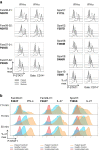The Extended Clinical Phenotype of 26 Patients with Chronic Mucocutaneous Candidiasis due to Gain-of-Function Mutations in STAT1
- PMID: 26604104
- PMCID: PMC4718942
- DOI: 10.1007/s10875-015-0214-9
The Extended Clinical Phenotype of 26 Patients with Chronic Mucocutaneous Candidiasis due to Gain-of-Function Mutations in STAT1
Abstract
Purpose: Gain-of-function (GOF) mutations in the signal transducer and activator of transcription 1 (STAT1) result in unbalanced STAT signaling and cause immune dysregulation and immunodeficiency. The latter is often characterized by the susceptibility to recurrent Candida infections, resulting in the clinical picture of chronic mucocutaneous candidiasis (CMC). This study aims to assess the frequency of GOF STAT1 mutations in a large international cohort of CMC patients.
Methods: STAT1 was sequenced in genomic DNA from 57 CMC patients and 35 healthy family members. The functional relevance of nine different STAT1 variants was shown by flow cytometric analysis of STAT1 phosphorylation in patients' peripheral blood cells (PBMC) after stimulation with interferon (IFN)-α, IFN-γ or interleukin-27 respectively. Extended clinical data sets were collected and summarized for 26 patients.
Results: Heterozygous mutations within STAT1 were identified in 35 of 57 CMC patients (61%). Out of 39 familial cases from 11 families, 26 patients (67%) from 9 families and out of 18 sporadic cases, 9 patients (50%) were shown to have heterozygous mutations within STAT1. Thirteen distinct STAT1 mutations are reported in this paper. Eight of these mutations are known to cause CMC (p.M202V, p.A267V, p.R274W, p.R274Q, p.T385M, p.K388E, p.N397D, and p.F404Y). However, five STAT1 variants (p.F172L, p.Y287D, p.P293S, p.T385K and p.S466R) have not been reported before in CMC patients.
Conclusion: STAT1 mutations are frequently observed in patients suffering from CMC. Thus, sequence analysis of STAT1 in CMC patients is advised. Measurement of IFN- or IL-induced STAT1 phosphorylation in PBMC provides a fast and reliable diagnostic tool and should be carried out in addition to genetic testing.
Keywords: CMC; Chronic mucocutaneous candidiasis; GOF; PID; STAT1; gain-of-function; phosphorylation; primary immunodeficiency; signal transducer and activator of transcription 1.
Figures



References
-
- Eyerich K, Eyerich S, Hiller J, Behrendt H, Traidl-Hoffmann C. Chronic mucocutaneous candidiasis, from bench to bedside. Eur J Dermatol. 2010;20(3):260–5. - PubMed
Publication types
MeSH terms
Substances
Grants and funding
LinkOut - more resources
Full Text Sources
Other Literature Sources
Medical
Molecular Biology Databases
Research Materials
Miscellaneous

